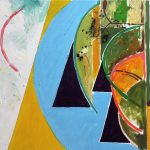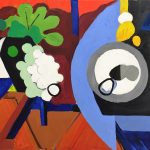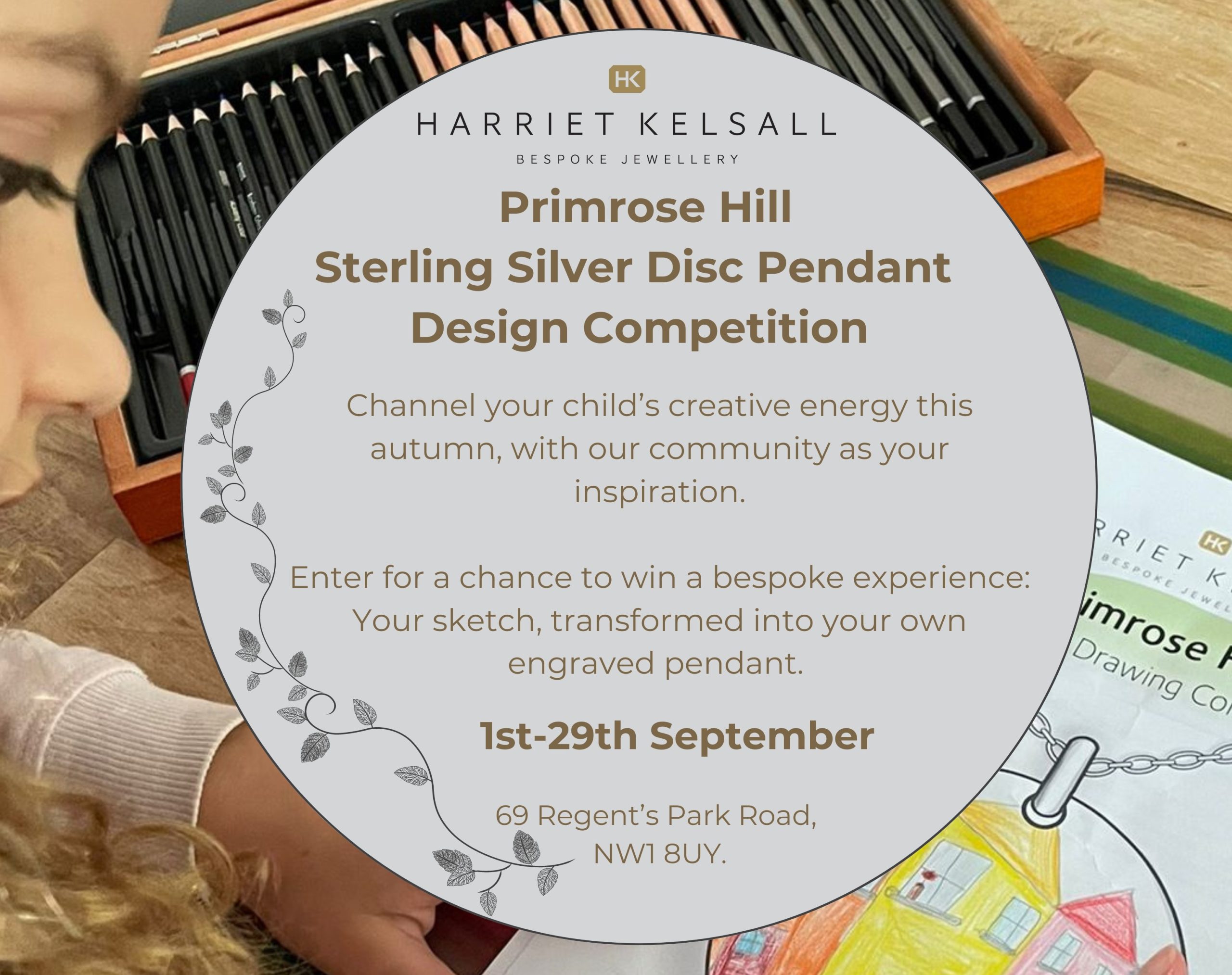In October, Primrose Hill artists Adrian Hemming and Andrew Marr held a joint exhibition at Art Bermondsey Project Space. Included in the catalogue was an account of their artistic friendship which is reproduced here.
Marr . . . on Hemming
Painting is, necessarily, a solitary occupation. Everything that matters most about it takes place silently, in the brain of the painter. In the studio, when the hard work is being done, the silence is absolute. And yet every painter needs to talk – needs help, needs criticism, needs a frank and knowing friendship. So, when I began to try to paint seriously, after I had suffered a stroke, Adrian Hemming’s friendship was both wonderful luck and a lifeline. He comes into the studio, raises a quizzical eyebrow, perhaps shakes his head about something that had pleased me, and quietly, gently, suggests other directions I might follow. And he’s always right. Adrian and I started to talk because we live close to one another, have numerous mutual friends, and do not fanatically abjure Pale Ale. But the basis of our friendship and relationship is painting, painting and painting.
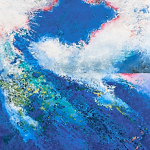 I always call Adrian, with a slight note of jealousy in my voice, ‘a proper painter’. Unlike me, he has gone through a full and rigorous training. He has devoted his entire life since teenage-hood to mastering pigment and surface, design and meaning. And, by God, it shows. Working in his Islington studio, he is meticulously picky about the colours he uses, and mostly grinds for himself (the Unison Company of Northumberland’s A19 Ultramarine being a particular favourite). The walls around him are hung with the latest work, which is always and forever work in progress: Adrian is a great believer in the virtues of pitiless obliteration. Anything that may seem easy about his painting has been very hard won. In fact, one of the first lessons he taught me was that even what one might consider to be a fine passage of painting – square inches one is quietly delighted with – must often be overpainted or rubbed out in the higher interests of a completed work.
I always call Adrian, with a slight note of jealousy in my voice, ‘a proper painter’. Unlike me, he has gone through a full and rigorous training. He has devoted his entire life since teenage-hood to mastering pigment and surface, design and meaning. And, by God, it shows. Working in his Islington studio, he is meticulously picky about the colours he uses, and mostly grinds for himself (the Unison Company of Northumberland’s A19 Ultramarine being a particular favourite). The walls around him are hung with the latest work, which is always and forever work in progress: Adrian is a great believer in the virtues of pitiless obliteration. Anything that may seem easy about his painting has been very hard won. In fact, one of the first lessons he taught me was that even what one might consider to be a fine passage of painting – square inches one is quietly delighted with – must often be overpainted or rubbed out in the higher interests of a completed work.
This way of painting produces a surface that must be looked at near at hand. What I particularly value in Adrian’s art is the rich, rucked textures, the densely worked, scored and often extremely complex surface area he achieves. Let me explain why I think this matters so much. We live in a world dominated by flat, glossy, glassy screens. Today’s digital manipulation is boundless and endless. And, just as with the original invention of chemical photography in the nineteenth century, this technical revolution throws problems to today’s painters.
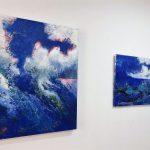 How does handmade, traditional art respond? Should we become video artists? Should we give up pencils for apps on the iPad? Both of us believe that the flatness of the digital world must send painting in the opposite direction, back to the claggy materiality, the ‘thisness’ of oil and pigment. To be radical today is to insist on the organic essence and origins of the tradition; and I would argue that you can read this very clearly in the texture of a Hemming. (Which means you need to look at the paintings: reproductions, however good, are not nearly enough.) But – and this is not a skill I have yet achieved – Adrian’s densely worked passages occur only in harmony with larger areas of calm. The frenzy is more frenzied when surrounded by lapping quiet blues or greens.
How does handmade, traditional art respond? Should we become video artists? Should we give up pencils for apps on the iPad? Both of us believe that the flatness of the digital world must send painting in the opposite direction, back to the claggy materiality, the ‘thisness’ of oil and pigment. To be radical today is to insist on the organic essence and origins of the tradition; and I would argue that you can read this very clearly in the texture of a Hemming. (Which means you need to look at the paintings: reproductions, however good, are not nearly enough.) But – and this is not a skill I have yet achieved – Adrian’s densely worked passages occur only in harmony with larger areas of calm. The frenzy is more frenzied when surrounded by lapping quiet blues or greens.
Although, when we talk, we mainly talk about the craft and physicality of painting – about pigments, bristles, different oils and glazes – Adrian Hemming is a philosophical painter, much concerned with myth, the environment and the nature of perception. Above all he is trying to answer the most difficult and important question painters’ face, which is simply: ‘What should fresh painting look like in 2017?’
All of us who paint do so with the huge weight of the Western tradition sitting on our shoulders. At times it can seem as if every idea has been had before. Perhaps every design, motif, colour combination has been done better already; perhaps all that is left, even for a serious and honest painter, is quotation. Adrian, like me, is a fascinated and obsessive looker, a haunter of exhibitions by greats. When we flop down in our nearest pub – the Lansdowne in Gloucester Avenue – we are often talking about the latest Rauschenberg show, or Howard Hodgkin or Peter Lanyon or Patrick Heron. Adrian was taught by, among others, the painter I would regard as the most successful non-representational living British artist, Gillian Ayres. Yet he has managed that great feat: a Hemming, whatever its size, shape and colour range, looks like a Hemming and nothing else. He has absorbed, ingested and then quietly gone his own way.
I admire him so much for that. Since my stroke, I have had a much more intense sense of the importance of going your own way. Not a day passes when I don’t think about how little time is left; and for me this means a redoubled effort to paint better, because it is the best way of expressing my personal sense of what it means to be alive. Although this might seem a somewhat solemn undertaking, and it is certainly a strenuous one, it is in fact full of joyousness. When I am painting badly, I drive myself into a rage. But when I am painting well, I feel full of delight. A big part of that delight has come about thanks to the calm, wise friendship, and peaceable advice given to me by Adrian Hemming. A lesser man would have tried to encourage me to paint just like him: Adrian has helped me to paint like me, only better – a much harder task. As you observe these pictures, I hope you see the story of an artistic friendship too.
Hemming . . . on Marr
I first encountered Andrew (or rather I didn’t but used to observe him) rapt with attention, painting on Primrose Hill and I knew that the last thing an artist wants in those situations is an old git like me interrupting him to say: ‘Hi, you must be Andrew Marr.’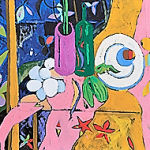
A time and a place for everything. So, finally I did meet him and he kindly invited me to his studio. It was a revelation. Not because the work was amazing then, but I could see and sense that it was the start of a serious, momentous, lifetime journey. I don’t mean the physical journey he has had to endure, but I mean the journey that all artists undertake if they are truly going to call themselves artists. Yes, it’s difficult, of course the journey is obscure, it’s about many, many things. It’s about seeing inside one’s self and the world around us, it’s not just surface detail. The stroke has changed his attitudes to painting, making him determined to become ‘a real painter’ – to quote Andrew himself. Remember, this is a man who has never been to art college, so he has missed out on all those interconnecting threads of art practice, but at the same time it has also freed him from the shackles of art college expectations. He has exploded from being a Sunday painter to becoming a fascinating artist. Since that initial meeting I have been back to his studio many times and have been privileged to observe these changes in his art.
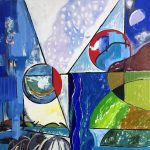 A big influence on his work is the paintings and prints of Gillian Ayres, as they both share a similar response to post-war British abstraction. Since his stroke, the imagery of his work has changed radically and, in my perception, for the better. He has moved from landscape realism, like the Primrose Hill work, to a much more demanding and exciting iconography of abstraction. He works in oil paint on canvas and board. His subjects are abstract motifs and shapes, floating on highly coloured backgrounds. They gain their excitement and visual energy from the push and pull of object to colour, each fighting for balance and/or dominance. However, he doesn’t slavishly copy other artists; he wants to distil the imagery from his own sensibility and the world around him to create a truthful comment on himself.
A big influence on his work is the paintings and prints of Gillian Ayres, as they both share a similar response to post-war British abstraction. Since his stroke, the imagery of his work has changed radically and, in my perception, for the better. He has moved from landscape realism, like the Primrose Hill work, to a much more demanding and exciting iconography of abstraction. He works in oil paint on canvas and board. His subjects are abstract motifs and shapes, floating on highly coloured backgrounds. They gain their excitement and visual energy from the push and pull of object to colour, each fighting for balance and/or dominance. However, he doesn’t slavishly copy other artists; he wants to distil the imagery from his own sensibility and the world around him to create a truthful comment on himself.
One of the notions behind Andrew’s work is how some artists have no aptitude for paint, the paint just gets sloshed on and as long as it conveys a message or object that’s all that matters. He is pushing his own work so that the look and feel of the paint is a big part of the message. It has to be sensuous. It has to be alive. There is a sense that the painting process is almost like being in psychoanalysis: there are deep layers of unconsciousness that you constantly try to understand. It’s both deeply satisfying and deeply disturbing at the same time. What I love about his work is that as more and more paintings come to fruition, this sense of the quality of the medium becomes more apparent and accomplished. It’s a joy to be a witness to that process.
I admire Andrew’s huge work ethic and his constant desire to innovate all the time. There is an urgency to his work, and he has told me that he feels time may not be on his side so he paints and pushes himself at a furious pace; whilst I, in contrast, stroll along to his studio humming a little ditty until confronted by him dragging out painting after painting dripping with wet oil and brandishing them at me, sometimes with total enthusiasm, other times as gloomy as Eeyore. We chat about the work, sometimes we have a lot to say, sometimes very little. It doesn’t really matter because what it does is reinforce his will power and his conviction to paint ‘good paintings’.
Of course, the next bit of the evening is the whole point of the exercise: and that is to retire to our local pub and down a couple of half and halfs.


